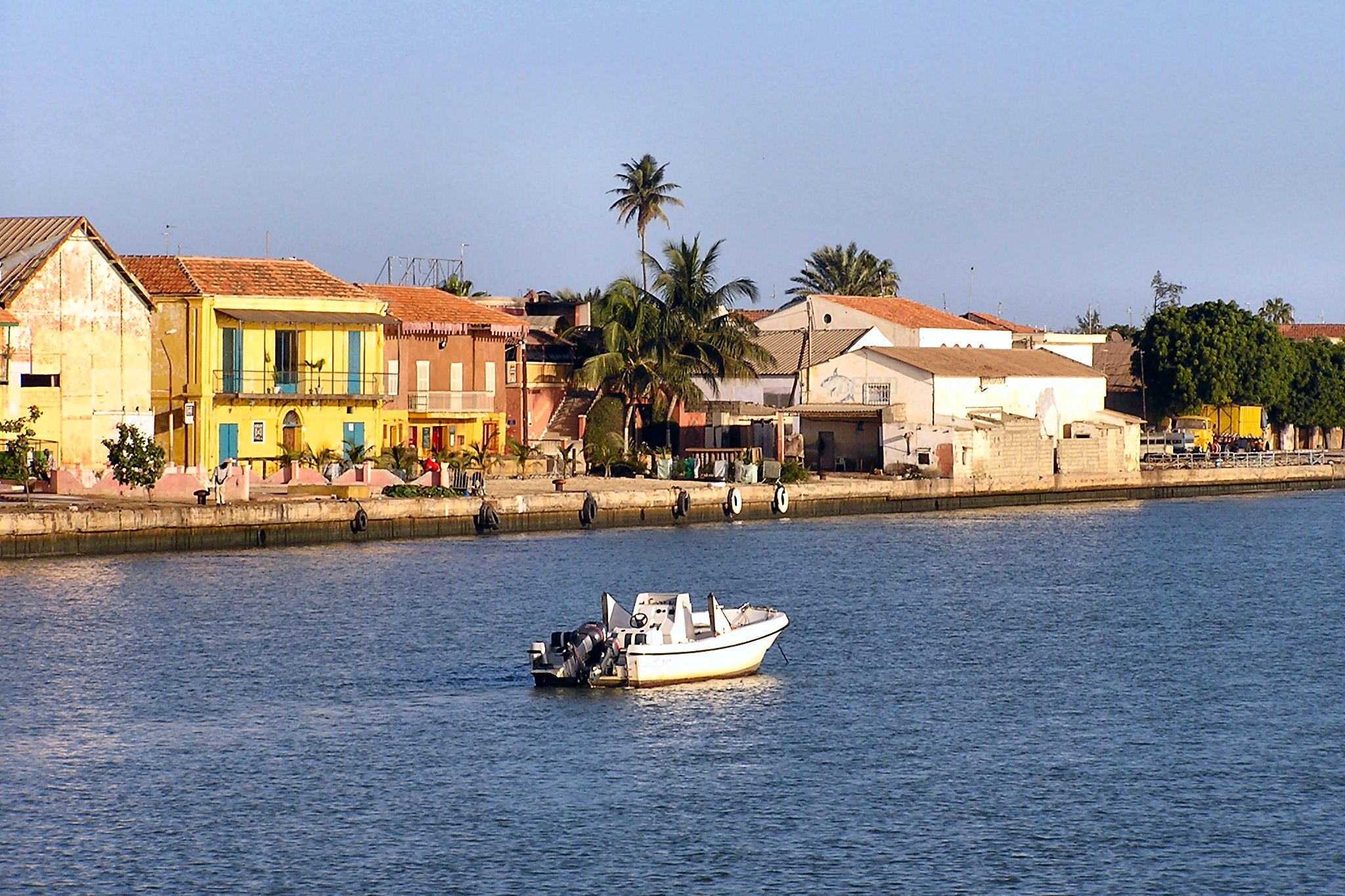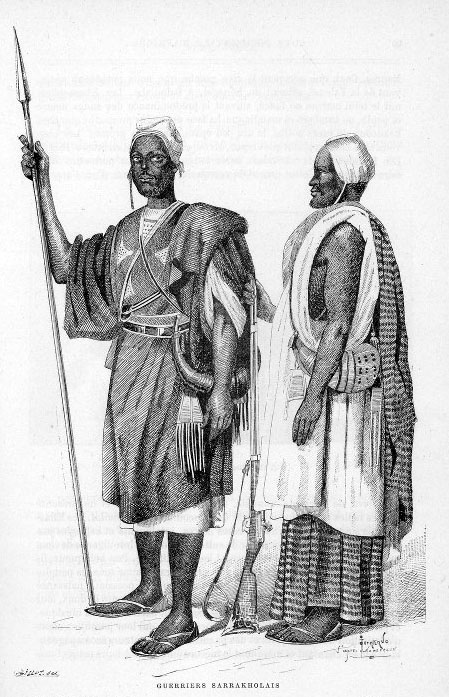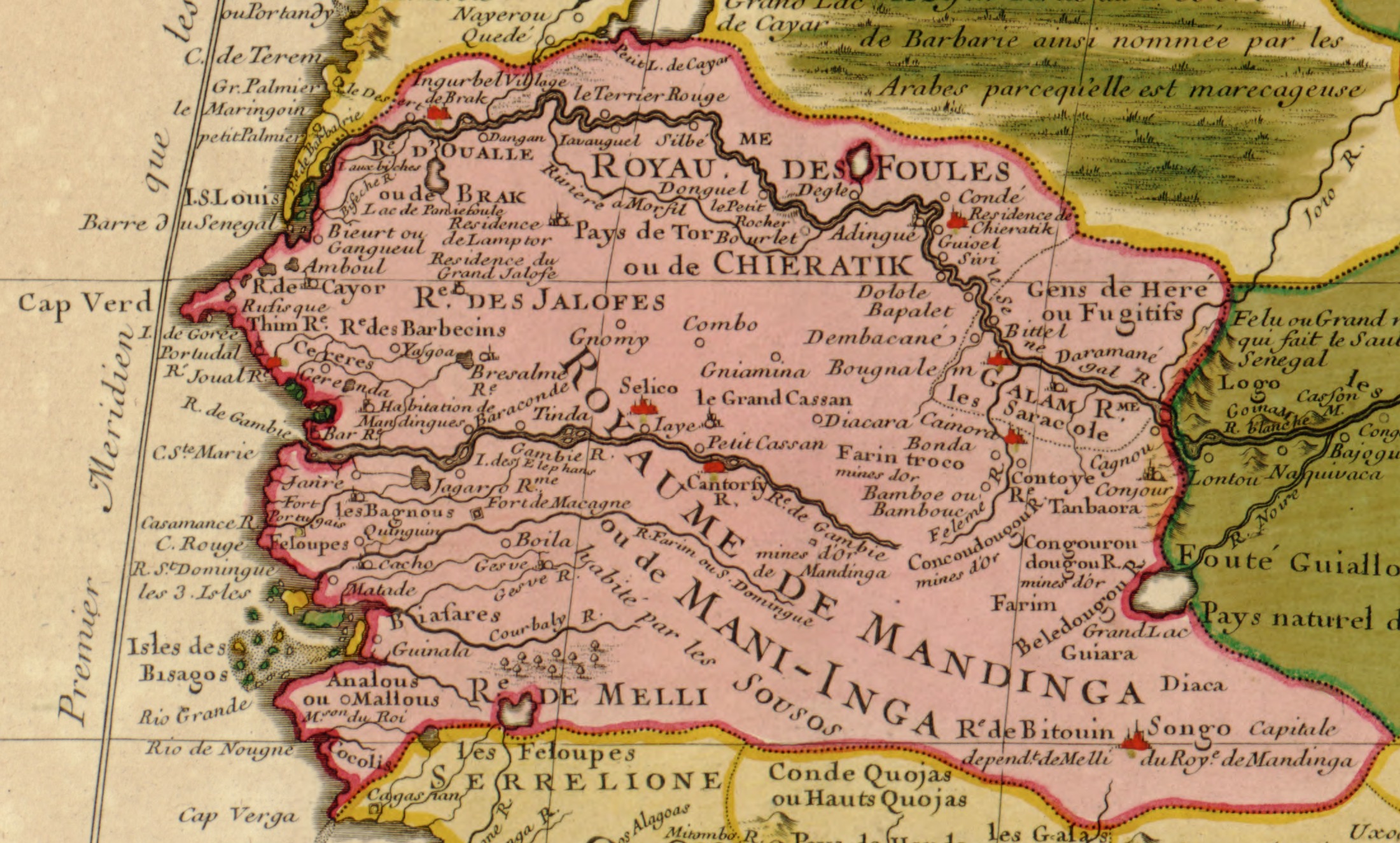|
Bakel, Senegal
Bakel is a town of approximately 15,000 inhabitants located in the eastern part of Senegal, West Africa. The town is located on the left bank of the Sénégal River, from the Malian border and linked by canoe ferry to the village of Gouraye in Mauritania. Bakel is one of the four eponymous departmental capitals in the region of Tambacounda, the other three being Tambacounda, Goudiry and Koumpentoum. Bakel is known for its French fort (Fort Bakel), which René Caillié visited in 1819. It was also the area where the Mauritanian crisis occurred, a dispute over grazing rights that led to a war between Senegal and Mauritania in 1989. As a result of this conflict, many people around the area moved abroad or emigrated to Senegal. People and Culture The majority of the population belong to the Soninke-speaking ethnic group, a dialect of the larger Mande Languages language family. There is also a substantial Pulaar (Fula) speaking minority as well as a significant amount of Bambara ... [...More Info...] [...Related Items...] OR: [Wikipedia] [Google] [Baidu] |
Regions Of Senegal
Senegal is subdivided into 14 regions (French: ''régions'', singular''région''), each of which is administered by a ''Conseil Régional'' (pl.: ''Conseils Régionaux'') elected by population weight at the arrondissement level. Senegal is further subdivided into 45 departments, 103 arrondissements (neither of which have administrative function) and by ''collectivités locales'' (the 14 ''regions'', 110 ''communes'', and 320 ''communautés rurales'') which elect administrative officers. from Union des ''Associations d’ Elus Locaux (UAEL) du Sénégal''. See also the law creating current local government structures Code de ... [...More Info...] [...Related Items...] OR: [Wikipedia] [Google] [Baidu] |
Bambara Language
Bambara (Arabic script: ), also known as Bamana (N'Ko script: ) or Bamanankan (), is a lingua franca and national language of Mali spoken by perhaps 15 million people, natively by 5 million Bambara people and about 10 million second-language users. It is estimated that about 80 percent of the population of Mali speak Bambara as a first or second language. It has a subject–object–verb clause structure and two lexical tones. Classification Bambara is a variety of a group of closely related languages called Manding, whose native speakers trace their cultural history to the medieval Mali Empire. Varieties of Manding are generally considered (among native speakers) to be mutually intelligible – dependent on exposure or familiarity with dialects between speakers – and spoken by 30 to 40 million people in the countries Burkina Faso, Senegal, Guinea-Bissau, Guinea, Liberia, Ivory Coast and the Gambia. Manding is part of the larger Mandé family of languages. Geographical dis ... [...More Info...] [...Related Items...] OR: [Wikipedia] [Google] [Baidu] |
Treaty Of Paris (1815)
The Treaty of Paris of 1815, also known as the Second Treaty of Paris, was signed on 20 November 1815 following the defeat and second abdication of Napoleon Bonaparte. In February, Napoleon had escaped from his exile on Elba; he entered Paris on 20 March, beginning the Hundred Days of his restored rule. After France's defeat at the hands of the Seventh Coalition in the Battle of Waterloo, Napoleon was persuaded to abdicate again, on 22 June. King Louis XVIII, who had fled the country when Napoleon arrived in Paris, took the throne for a second time on 8 July. The 1815 treaty had more punitive terms than the treaty of the previous year. France was ordered to pay 700 million francs in indemnities, and its borders were reduced to those that had existed on 1 January 1790. France was to pay additional money to cover the cost of providing additional defensive fortifications to be built by neighbouring Coalition countries. Under the terms of the treaty parts of France were to be occup ... [...More Info...] [...Related Items...] OR: [Wikipedia] [Google] [Baidu] |
Gorée
(; "Gorée Island"; Wolof: Beer Dun) is one of the 19 (i.e. districts) of the city of Dakar, Senegal. It is an island located at sea from the main harbour of Dakar (), famous as a destination for people interested in the Atlantic slave trade although its actual role in the history of the slave trade is the subject of dispute. Its population as of the 2013 census was 1,680 inhabitants, giving a density of , which is only half the average density of the city of Dakar. Gorée is both the smallest and the least populated of the 19 of Dakar. Other important centres for the slave trade from Senegal were further north, at Saint-Louis, Senegal, or to the south in the Gambia, at the mouths of major rivers for trade.''Les Guides Bleus: Afrique de l'Ouest'' (1958 ed.), p. 123 It is a UNESCO World Heritage Site and was one of the first 12 locations in the world to be designated as such in 1978. The name is a corruption of its original Dutch name , meaning "good roadstead". History ... [...More Info...] [...Related Items...] OR: [Wikipedia] [Google] [Baidu] |
Histoire Des Colonies-Guillon-Bakel (Sénégal)
Histoire (French for 'story' or 'history') may refer to: * Histoire TV, a French television channel * Historia (TV channel), or Canal Histoire, a Canadian television channel * ''L'Histoire'', a French magazine * , a 1967 novel by Claude Simon See also * , a Japanese manga comic book by Hitoshi Iwaaki * History (other) * Historia (other) Historia may refer to: * Historia, the local version of the History channel in Spain and Portugal * Historia (TV channel), a Canadian French language specialty channel * Historia (newspaper), a French monthly newspaper devoted to History topics * ... * Histories (other) {{Disambiguation ... [...More Info...] [...Related Items...] OR: [Wikipedia] [Google] [Baidu] |
Saint-Louis, Senegal
Saint Louis or Saint-Louis ( wo, Ndar), is the capital of Senegal's Saint-Louis Region. Located in the northwest of Senegal, near the mouth of the Senegal River, and 320 km north of Senegal's capital city Dakar, it has a population officially estimated at 258,592 in 2021. Saint-Louis was the capital of the French colony of Senegal from 1673 until 1902 and French West Africa from 1895 until 1902, when the capital was moved to Dakar. From 1920 to 1957, it also served as the capital of the neighboring colony of Mauritania. The town was an important economic center during French West Africa, but it is less important now. However it still has important industries, including tourism, a commercial center, a center of sugar production, and fishing. The Tourism industry is in part due to the city being listed as a UNESCO World Heritage Site in 2000. However, the city is also Climate change vulnerability, vulnerable to climate change—where sea level rise is expected to threaten the ci ... [...More Info...] [...Related Items...] OR: [Wikipedia] [Google] [Baidu] |
Soninke People
The Soninke people are a West African Mande-speaking ethnic group found in Mali, Fouta Djallon, southern Mauritania, eastern Senegal, Guinea and The Gambia. They speak the Soninke language, also called the Serakhulle or Azer language, which is one of the Mande languages. Soninke people were the founders of the ancient empire of Ghana or Wagadou c. 300–1240 CE, Subgroups of Soninke include the Maraka and Wangara. When the Ghana empire was destroyed, the resulting diaspora brought Soninkes to Mali, Mauritania, Senegal, Gambia, Burkina Faso, Côte d'Ivoire, Guinée-Conakry, modern-day Republic of Ghana, and Guinea-Bissau where some of this trading diaspora was called Wangara. Predominantly Muslims, the Soninke were one of the early ethnic groups from West Africa to convert to Islam in about the 10th century. The contemporary population of Soninke people is estimated to be over 2 million. The cultural practices of Soninke people are similar to the Mandé peoples, and those of ... [...More Info...] [...Related Items...] OR: [Wikipedia] [Google] [Baidu] |
History Of Senegal
The history of Senegal is commonly divided into a number of periods, encompassing the prehistoric era, the precolonial period, colonialism, and the contemporary era. Paleolithic The earliest evidence of human life is found in the valley of the Falémé in the south-east. The presence of man in the Lower Paleolithic is attested by the discovery of stone tools characteristic of Acheulean such as hand axes reported by Théodore Monod at the tip of Fann in the peninsula of Cap-Vert in 1938, or cleavers found in the south-east. There were also found stones shaped by the Levallois technique, characteristic of the Middle Paleolithic. Mousterian Industry is represented mainly by scrapers found in the peninsula of Cap-Vert, as well in the low and middle valleys of the Senegal and the Falémé. Some pieces are explicitly linked to hunting, like those found in Tiémassass, near M'Bour, a controversial site that some claim belongs to the Upper Paleolithic, while other argue in favor of ... [...More Info...] [...Related Items...] OR: [Wikipedia] [Google] [Baidu] |
Jolof Empire
{{dab ...
Jolof (french: Djolof or ') may refer to either of * Jolof Empire, a West African successor state to the Mali Empire in modern Senegal from the 14th to 16th centuries * Kingdom of Jolof, a rump survival of the earlier empire from the 16th to the 19th centuries See also * Jollof rice Jollof (), or jollof rice, is a rice dish from West Africa. The dish is typically made with long-grain rice, tomatoes, onions, spices, vegetables and meat in a single pot, although its ingredients and preparation methods vary across different re ... [...More Info...] [...Related Items...] OR: [Wikipedia] [Google] [Baidu] |
Fouta Toro
Futa Toro (Wolof and ff, Fuuta Tooro ''𞤆𞤵𞥄𞤼𞤢 𞤚𞤮𞥄𞤪𞤮''; ar, فوتا تورو), often simply the Futa, is a semidesert region around the middle run of the Senegal River. This region is along the border of Senegal and Mauritania. It is well watered and fertile close to the river, but the interior parts of the region away from the river is porous, dry and infertile. This region is historically significant for the Islamic theocracies, Fulani states, jihad armies and migrants for Fouta Djallon that emerged from here. Geography The Futa Toro stretches for about 400 kilometers, but of a narrow width of up to 20 kilometers on either side of the Senegal River. The western part is called Toro, the central and eastern parts called Futa. The central portion include Bosea, Yirlabe Hebbyabe, Law and Hailabe provinces. The eastern Futa includes Ngenar and Damga provinces. The region north and east to Futa Toro is barren Sahara. Historically, each of the Futa Toro g ... [...More Info...] [...Related Items...] OR: [Wikipedia] [Google] [Baidu] |
Marabout
A marabout ( ar, مُرابِط, murābiṭ, lit=one who is attached/garrisoned) is a Muslim religious leader and teacher who historically had the function of a chaplain serving as a part of an Islamic army, notably in North Africa and the Sahara, in West Africa, and (historically) in the Maghreb. The marabout is often a scholar of the Qur'an, or religious teacher. Others may be wandering holy men who survive on alms, Sufi Murshids ("Guides"), or leaders of religious communities. The term "marabout" is also used for the mausolea of such religious leaders (cf. ''maqam'', ''mazar'', in Palestine also ''wali/weli''). West Africa Muslim religious teachers Muslim tariqah (Sufi religious brotherhoods) are one of the main organizing forms of West African Islam, and with the spread of Sufi ideas into the area, the marabout's role combined with local practices throughout Senegambia, the Niger River Valley, and the Futa Jallon. Here, Sufi believers follow a marabout, elsewhere know ... [...More Info...] [...Related Items...] OR: [Wikipedia] [Google] [Baidu] |
Booba
Élie Yaffa (; born 9 December 1976), better known under his stage name Booba, is a French rapper. After a brief stint as a break dancer in the early 1990s, Booba partnered with his friend Ali to form Lunatic. The duo released a critically acclaimed album in 2000 but disbanded in 2003. Booba has since embarked on a successful solo career, selling more than 10 million discs over his career and becoming the most legally downloaded artist in French history. Booba is praised for the quality of his flow and beats but often criticized because of the controversial nature of his lyrics. He has also established the rap label Tallac Records, and developed a line of jewellery. Life and career Élie Yaffa was born on 9 December 1976 in the outskirts of Paris in Sèvres. His father is Senegalese and his mother is French of Mosellan and Belgian descent. With his friend Ali they formed the duo Lunatic in 1994. Unable to secure a record deal from a major label because of their controvers ... [...More Info...] [...Related Items...] OR: [Wikipedia] [Google] [Baidu] |
.jpg)





.png)
